Abstract
This study examines whether an aldose reductase inhibitor (statil, ICI) can enhance neutrophil oxidative killing by diabetic neutrophils. We have examined a radiometric assay of phagocytosis and killing of Candida albicans by neutrophils from 20 controls and 20 subjects with insulin-dependent diabetes under various in vitro glucose concentrations. Glucose was present at 5, 10 and 20 mM in the presence and absence of statil (11 microM). Phagocytosis was unaffected by raised glucose levels in controls and in diabetic subjects. Killing by the diabetic cells was inhibited by increasing concentrations of glucose, killing was 18.9 +/- 2.0, 16.9 +/- 2.4 and 14.8 +/- 2.0% (mean +/- s.e.m.) at 5, 10 and 20 mM glucose, respectively (P less than 0.05). With the addition of statil under the same conditions killing improved to 19.3 +/- 2.0, 23.2 +/- 2.2 and 23.6 +/- 2.4 (P less than 0.01), these values were similar to the controls (P greater than 0.01). We conclude therefore that aldose reductase inhibition restores oxidative killing to normal.
Full text
PDF
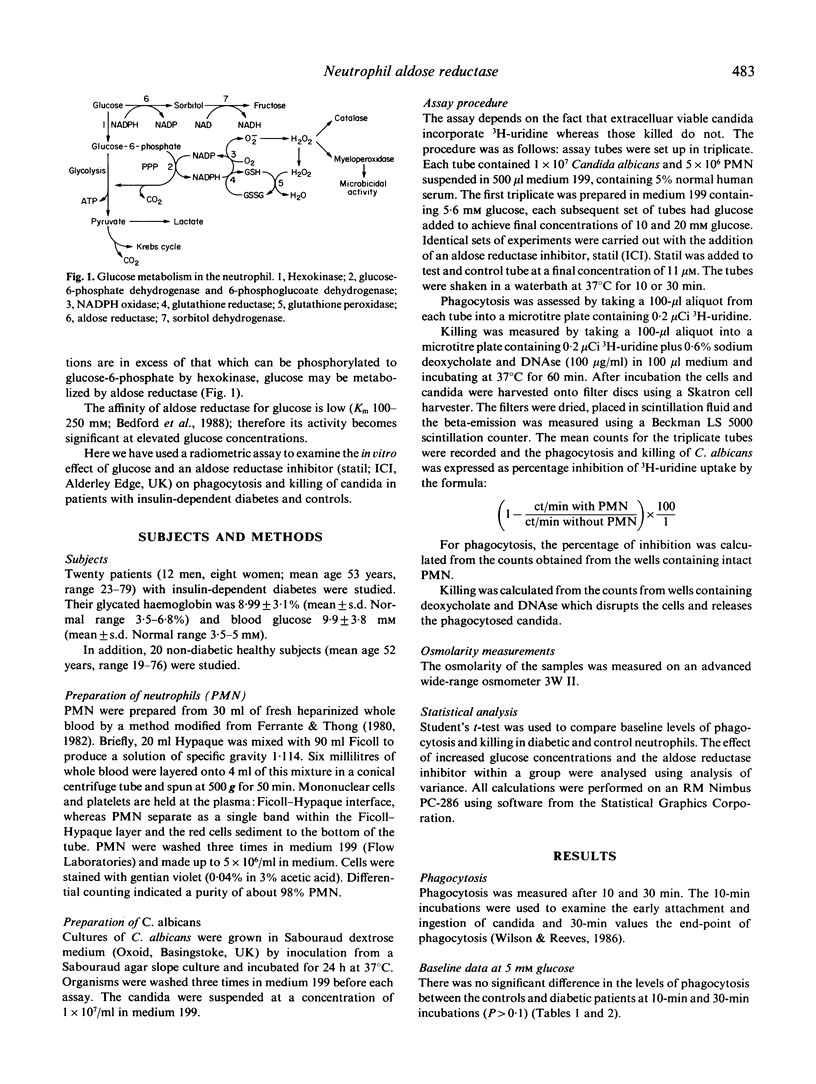
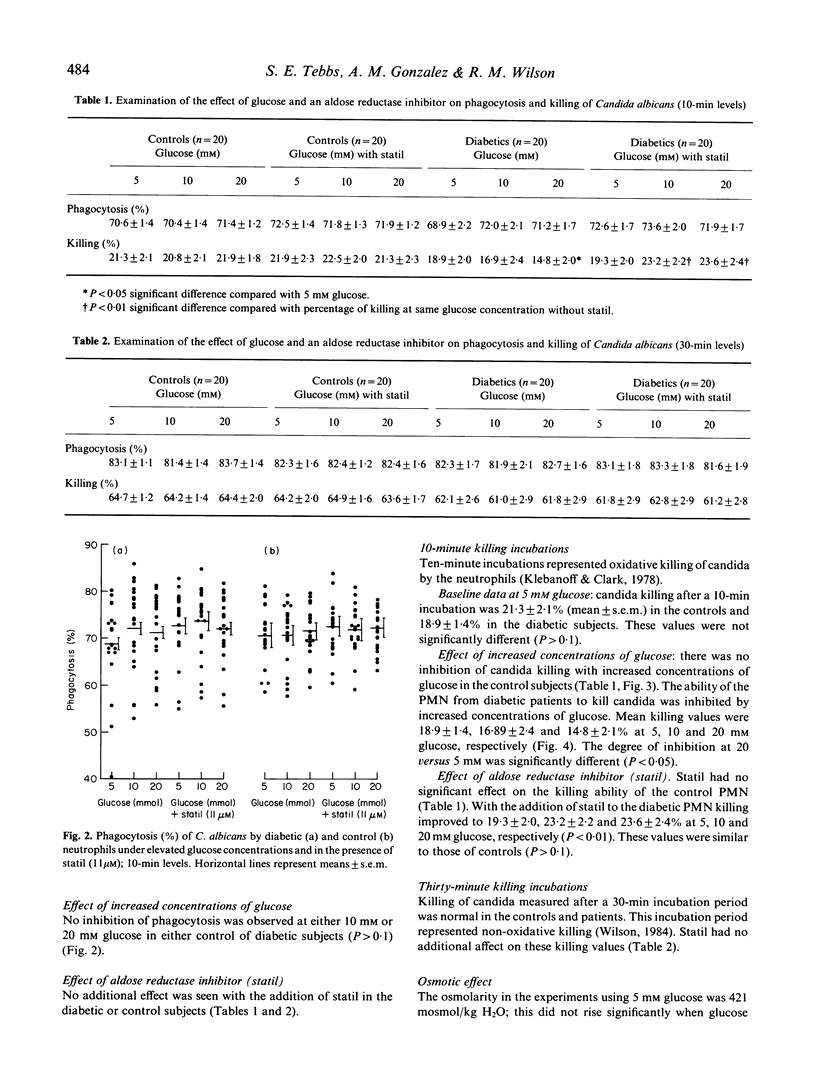
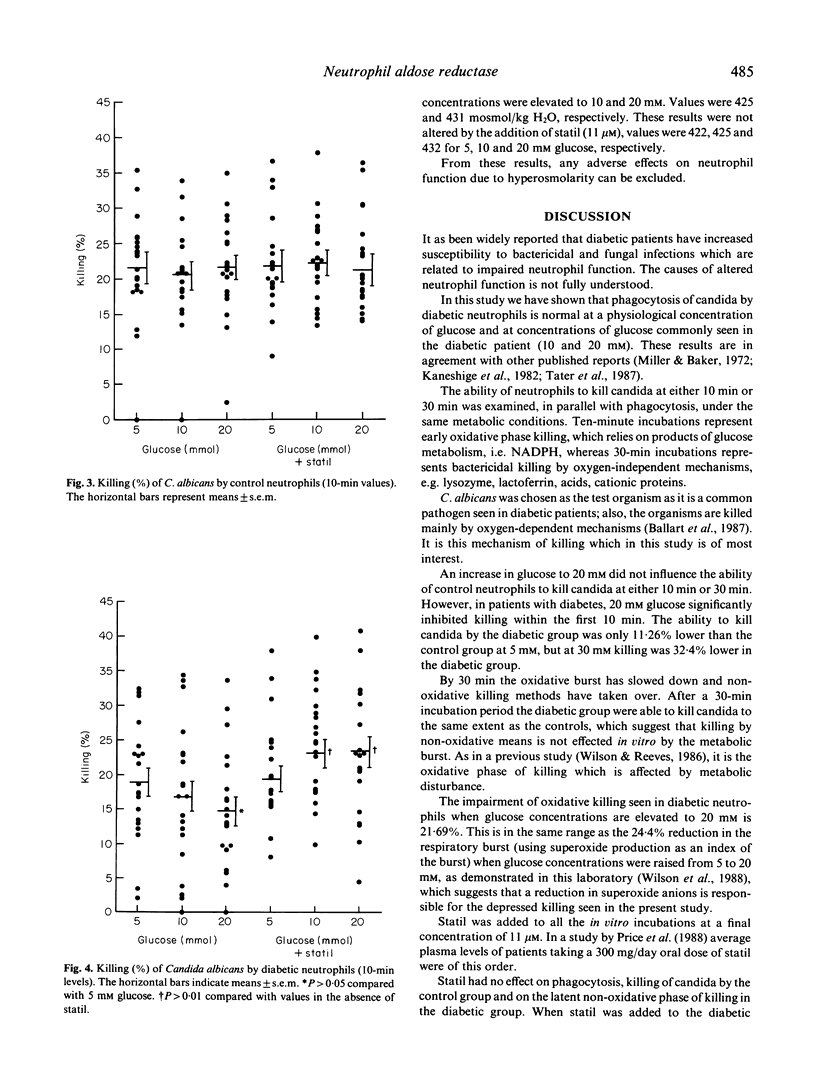
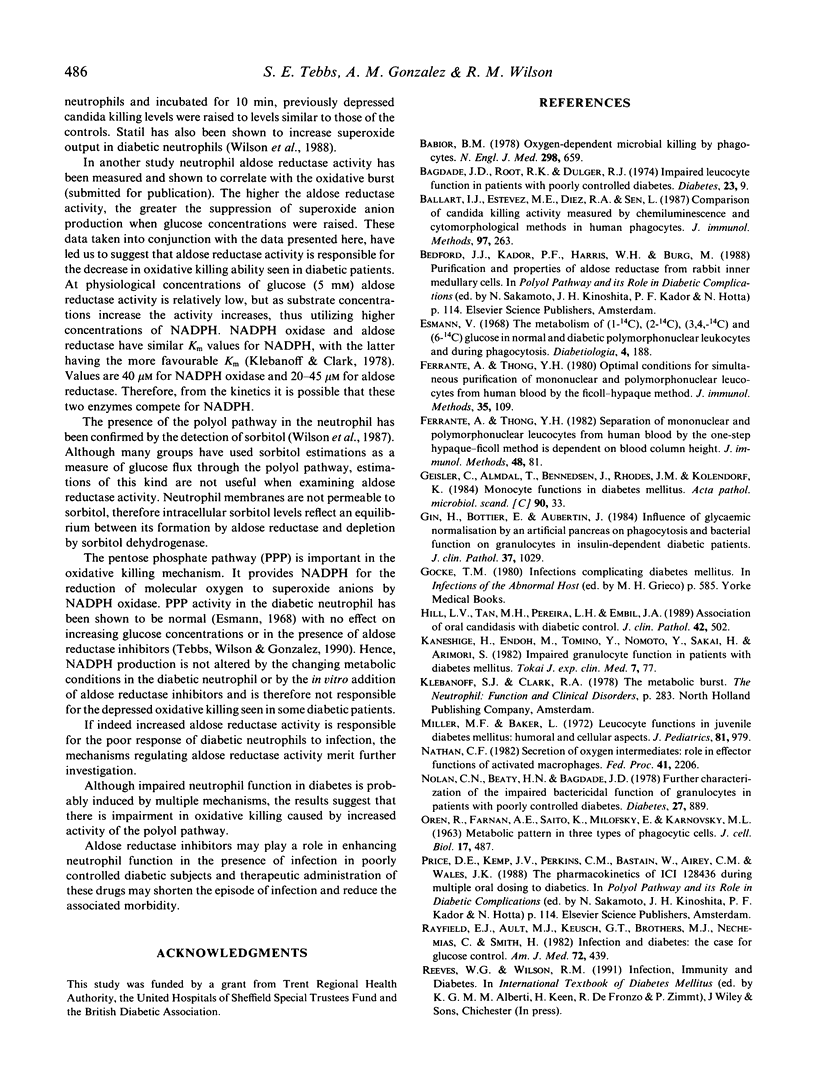
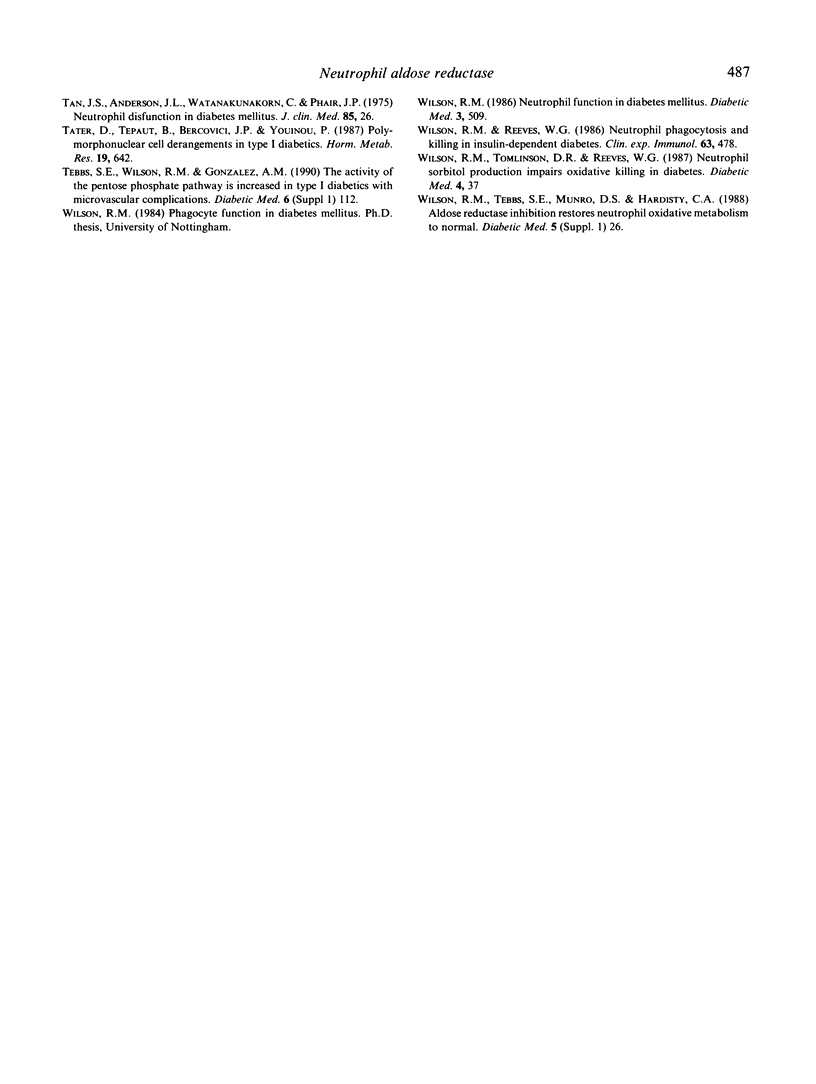
Selected References
These references are in PubMed. This may not be the complete list of references from this article.
- Babior B. M. Oxygen-dependent microbial killing by phagocytes (first of two parts). N Engl J Med. 1978 Mar 23;298(12):659–668. doi: 10.1056/NEJM197803232981205. [DOI] [PubMed] [Google Scholar]
- Bagdade J. D., Root R. K., Bulger R. J. Impaired leukocyte function in patients with poorly controlled diabetes. Diabetes. 1974 Jan;23(1):9–15. doi: 10.2337/diab.23.1.9. [DOI] [PubMed] [Google Scholar]
- Ballart I. J., Estevez M. E., Diez R. A., Sen L. Comparison of Candida killing activity measured by chemiluminescence and cytomorphological methods in human phagocytes. J Immunol Methods. 1987 Mar 12;97(2):263–268. doi: 10.1016/0022-1759(87)90469-8. [DOI] [PubMed] [Google Scholar]
- Esmann V. The metabolism of (1-14C)-,(2-14C)-,(3,4-14C)-, and (6-14C)-glucose in normal and diabetic polymorphonuclear leukocytes and during phagocytosis. Diabetologia. 1968 Aug;4(4):188–194. doi: 10.1007/BF00430094. [DOI] [PubMed] [Google Scholar]
- Ferrante A., Thong Y. H. Optimal conditions for simultaneous purification of mononuclear and polymorphonuclear leucocytes from human blood by the Hypaque-Ficoll method. J Immunol Methods. 1980;36(2):109–117. doi: 10.1016/0022-1759(80)90036-8. [DOI] [PubMed] [Google Scholar]
- Ferrante A., Thong Y. H. Separation of mononuclear and polymorphonuclear leucocytes from human blood by the one-step Hypaque-Ficoll method is dependent on blood column height. J Immunol Methods. 1982;48(1):81–85. doi: 10.1016/0022-1759(82)90212-5. [DOI] [PubMed] [Google Scholar]
- Gin H., Brottier E., Aubertin J. Influence of glycaemic normalisation by an artificial pancreas on phagocytic and bactericidal functions of granulocytes in insulin dependent diabetic patients. J Clin Pathol. 1984 Sep;37(9):1029–1031. doi: 10.1136/jcp.37.9.1029. [DOI] [PMC free article] [PubMed] [Google Scholar]
- Hill L. V., Tan M. H., Pereira L. H., Embil J. A. Association of oral candidiasis with diabetic control. J Clin Pathol. 1989 May;42(5):502–505. doi: 10.1136/jcp.42.5.502. [DOI] [PMC free article] [PubMed] [Google Scholar]
- Miller M. E., Baker L. Leukocyte functions in juvenile diabetes mellitus: humoral and cellular aspects. J Pediatr. 1972 Nov;81(5):979–982. doi: 10.1016/s0022-3476(72)80555-9. [DOI] [PubMed] [Google Scholar]
- Nathan C. F. Secretion of oxygen intermediates: role in effector functions of activated macrophages. Fed Proc. 1982 Apr;41(6):2206–2211. [PubMed] [Google Scholar]
- Nolan C. M., Beaty H. N., Bagdade J. D. Further characterization of the impaired bactericidal function of granulocytes in patients with poorly controlled diabetes. Diabetes. 1978 Sep;27(9):889–894. doi: 10.2337/diab.27.9.889. [DOI] [PubMed] [Google Scholar]
- OREN R., FARNHAM A. E., SAITO K., MILOFSKY E., KARNOVSKY M. L. Metabolic patterns in three types of phagocytizing cells. J Cell Biol. 1963 Jun;17:487–501. doi: 10.1083/jcb.17.3.487. [DOI] [PMC free article] [PubMed] [Google Scholar]
- Rayfield E. J., Ault M. J., Keusch G. T., Brothers M. J., Nechemias C., Smith H. Infection and diabetes: the case for glucose control. Am J Med. 1982 Mar;72(3):439–450. doi: 10.1016/0002-9343(82)90511-3. [DOI] [PubMed] [Google Scholar]
- Tan J. S., Anderson J. L., Watanakunakorn C., Phair J. P. Neutrophil dysfunction in diabetes mellitus. J Lab Clin Med. 1975 Jan;85(1):26–33. [PubMed] [Google Scholar]
- Tater D., Tepaut B., Bercovici J. P., Youinou P. Polymorphonuclear cell derangements in type I diabetes. Horm Metab Res. 1987 Dec;19(12):642–647. doi: 10.1055/s-2007-1011899. [DOI] [PubMed] [Google Scholar]
- Wilson R. M. Neutrophil function in diabetes. Diabet Med. 1986 Nov-Dec;3(6):509–512. doi: 10.1111/j.1464-5491.1986.tb00806.x. [DOI] [PubMed] [Google Scholar]
- Wilson R. M., Reeves W. G. Neutrophil phagocytosis and killing in insulin-dependent diabetes. Clin Exp Immunol. 1986 Feb;63(2):478–484. [PMC free article] [PubMed] [Google Scholar]


